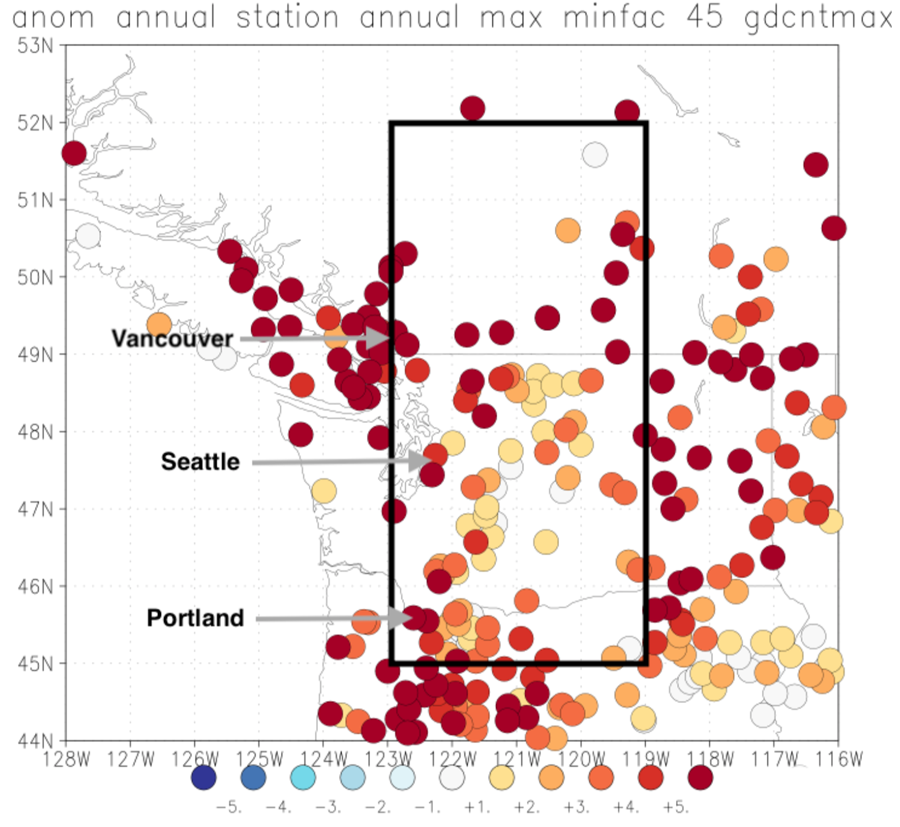Multiple cities in the U.S. states of Oregon and Washington and the western provinces of Canada recorded temperatures far above 40ºC (104 ºF), including setting a new all-time Canadian temperature record of 49.6ºC in the village of Lytton. Shortly after setting the record, Lytton was largely destroyed in a wildfire [1,2]. The exceptionally high temperatures led to spikes in sudden deaths, and sharp increases in hospital visits for heat-related illnesses and emergency calls [3,4,5]. Heatwaves are one of the deadliest natural hazards and this heatwave affected a population unaccustomed and unprepared for such extreme temperatures, for instance with most homes lacking air-conditioning [6]. Currently available mortality estimates of at least several hundred additional deaths are almost certainly an underestimate. The full extent of the impact of this exceptional heat on population health will not be known for several months.
Scientists from the US, Canada, the UK, the Netherlands, France, Germany and Switzerland collaborated to assess to what extent human-induced climate change made this heatwave hotter and more likely.
Using published peer-reviewed methods, we analysed how human-induced climate change affected the maximum temperatures in the region where most people have been affected by the heat (45–52 ºN, 119–123 ºW) including the cities of Seattle, Portland, and Vancouver (with well over 9 million people in their combined metropolitan areas).

Main findings
- Based on observations and modeling, the occurrence of a heatwave with maximum daily temperatures (TXx) as observed in the area 45–52 ºN, 119–123 ºW, was virtually impossible without human-caused climate change.
- The observed temperatures were so extreme that they lie far outside the range of historically observed temperatures. This makes it hard to quantify with confidence how rare the event was. In the most realistic statistical analysis the event is estimated to be about a 1 in 1000 year event in today’s climate.
- There are two possible sources of this extreme jump in peak temperatures. The first is that this is a very low probability event, even in the current climate which already includes about 1.2°C of global warming — the statistical equivalent of really bad luck, albeit aggravated by climate change. The second option is that nonlinear interactions in the climate have substantially increased the probability of such extreme heat, much beyond the gradual increase in heat extremes that has been observed up to now. We need to investigate the second possibility further, although we note the climate models do not show it. All numbers below assume that the heatwave was a very low probability event that was not caused by new nonlinearities.
- With this assumption and combining the results from the analysis of climate models and weather observations, an event, defined as daily maximum temperatures (TXx) in the heatwave region, as rare as 1 in a 1000 years would have been at least 150 times rarer without human-induced climate change.
- Also, this heatwave was about 2°C hotter than it would have been if it had occurred at the beginning of the industrial revolution (when global mean temperatures were 1.2°C cooler than today).
- Looking into the future, in a world with 2°C of global warming (0.8°C warmer than today which at current emission levels would be reached as early as the 2040s), this event would have been another degree hotter. An event like this – currently estimated to occur only once every 1000 years, would occur roughly every 5 to 10 years in that future world with 2°C of global warming.
In summary, an event such as the Pacific Northwest 2021 heatwave is still rare or extremely rare in today’s climate, yet would be virtually impossible without human-caused climate change. As warming continues, it will become a lot less rare.
Our results provide a strong warning: our rapidly warming climate is bringing us into uncharted territory that has significant consequences for health, well-being, and livelihoods. Adaptation and mitigation are urgently needed to prepare societies for a very different future. Adaptation measures need to be much more ambitious and take account of the rising risk of heatwaves around the world, including surprises such as this unexpected extreme. Deaths from extreme heat can be dramatically reduced with adequate preparedness action. Heat action plans that incorporate heatwave early warning systems can strengthen the resilience of cities and people. In addition, longer-term plans are needed to modify our built environments to be more adequate for the hotter climate that we already experience today and the additional warming that we expect in future. In addition, greenhouse gas mitigation goals should take into account the increasing risks associated with unprecedented climate conditions if warming would be allowed to continue
Background information
The heatwave considered in this study is linked to a slow-moving strong high pressure system, sometimes called Omega-blocking or “heat dome”, which brings descending and thus warm and dry air, as well clear skies, further heating the near-surface air. This high pressure system also reached record levels in terms of its strength, measured as the “thickness” of the lower part of the atmosphere, the so-called troposphere. The pressure values observed in the very strong blocking anticyclone are comparable to those observed in other parts of the world in recent heatwaves. The “Omega” blocking pattern is typically associated with heatwaves in this region. While the pressure system was record-breaking in its values, it was far less unusual compared to climatology than the associated extreme temperatures. Recent research suggests that climate change increases the chances for such stagnant high pressure systems in summer through weakening of the summer jet stream. As of yet, it is unclear if, and to what extent, such long-term dynamical changes play a role in this event.
An important feature of this extreme heatwave is that it occurred following a very dry spring over the Western U.S., so the absence of evaporative cooling could be an important factor in the exceptional temperatures observed. However, the northern part of the region impacted by this heatwave experienced wet anomalies in the weeks and months preceding the heat. Anticyclonic subsidence, and downslope winds were also present, and probably acted as additional heating factors. Overall, it is difficult at this stage to assess the extent to which these factors either in isolation or combined provide a good explanation of why the observed temperatures were so much higher than anything ever recorded in this part of the world. Hence, more research is needed to understand the processes as well as potential influence of human-caused climate change on them.
Here we provide a first estimate of the role of climate change on the extreme temperatures measured in the Pacific Northwest. We analyse the maximum daily temperatures as these are relevant to the impact of the event. While the minimum temperatures are also important for health impacts, we used only one index to keep the assessment straightforward. In this rapid study, we do not analyse the impact that human-caused climate change may have on specific aspects leading to the observed synoptic situation. We ask whether and to what extent human-caused climate change altered the likelihood and intensity of the analysed event. Specifically we analyse (1) how the likelihood of the yearly maximum temperature to be as high or higher than observed in June 2021 has changed and (2) how much less severe a heatwave with the same return period would have been in a world without human-caused climate change. It is important to highlight that, because the temperature records of June 2021 were very far outside all historical observations, determining the likelihood of this event in today’s climate is highly uncertain. All numbers shown assume that the heatwave was a very low probability event (about 1 in 1000 years) that was not caused by new nonlinearities. As in previous analyses, we only give a lower bound of the estimate of the influence of climate change on the change in probability of the event as the best estimate and upper bound are very ill-defined for extreme heat.
Based on this first rapid analysis, we cannot say whether this was a so-called “freak” event (with a return time on the order of 1 in 1000 years or more) that largely occurred by chance, or whether our changing climate altered conditions conducive to heatwaves in the Pacific Northwest, which would imply that “bad luck” played a smaller role and this type of event would be more frequent in our current climate.
In either case, the future will be characterized by more frequent, more severe, and longer heatwaves, highlighting the importance of significantly reducing our greenhouse gas emissions to reduce the amount of additional warming.
The latest heat-related death numbers are alarming, yet they are likely a severe undercount and the real toll will only become clear after mortality statistics are reviewed for the role of heat in exacerbating underlying conditions.
References
[1] World Meterological Organization: June ends with exceptional heat
[2] Global News: Scenes of destruction after wildfire destroys village of Lytton, B.C.
[3] Vancouver Sun: Heat wave linked to massive spike in sudden deaths across Lower Mainland
[4] Oregon Health Authority: Summer 2021 Oregon ESSENCE Hazard Report
[5] CNN: Historic Northwest heat wave linked to dozens of deaths and hundreds of emergency room visits
[6] New York Times: Air-Conditioning Was Once Taboo in Seattle. Not Anymore.





